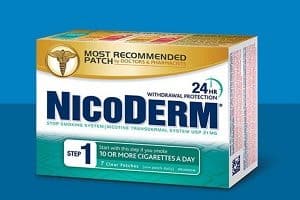
Smoking Cessation Medication NicoDerm. According to a study conducted by GlaxoSmithKline, Chantix—a smoking cessation medication recently making headlines for unusual side effects being reported in those taking the drug—is no better at helping patients quit smoking than therapeutic nicotine (TN), such as NicoDerm. Glaxo is maker of the smoking cessation medication NicoDerm and Pfizer makes […]

Smoking Cessation Medication NicoDerm. According to a study conducted by GlaxoSmithKline, Chantix—a smoking cessation medication recently making headlines for unusual side effects being reported in those taking the drug—is no better at helping patients quit smoking than therapeutic nicotine (TN), such as NicoDerm. Glaxo is maker of the smoking cessation medication NicoDerm and Pfizer makes Chantix.
Glaxo’s findings were published today in the August issue of Thorax and claim there is no significant differences in six-month and one-year quit rates between the NicoDerm(R) CQ(R) Clear Patch and Chantix (varenicline tartrate), even though “statistically higher quit rates are shown for Chantix at 12 weeks.” According to the official 2008 U.S. Public Health Service Guideline, “longer-term quit rates at the six-month milestone are the most predictive of long-term success.”
The Thorax paper, entitled, “Varenicline Versus Transdermal Nicotine Patch for Smoking Cessation: Results from a Randomised Open-Label Trial,” reports on a 52-week study–the first-ever direct comparison of the NicoDerm CQ Clear Patch to Chantix.
The study used an “open-label” design. In other words, subjects knew the medications they were taking. “This study confirms that there is no magic bullet when it comes to smoking cessation and that both therapeutic nicotine and Chantix (varenicline tartrate) demonstrate long-term effectiveness,” stated Dr. Howard Marsh, vice president of Worldwide Medical Affairs for Glaxo Consumer Healthcare. “There is also no single approach that will work for everyone. For example, a substantial proportion of quit attempts are made spontaneously, without much planning. Therapeutic nicotine is widely available without the need for a prescription or a visit to a doctor’s office.”
Although each smoking cessation medicine was proven effective, in separate double blind placebo-controlled studies for NicoDerm CQ and Chantix, NicoDerm saw a 45 percent success rate, versus 18 percent for placebo, following the end of a 10-week treatment; Chantix saw a 44 percent success rate versus 18 percent for placebo following 12-week treatment.
The NicoDerm CQ patch and other TN products help reduce nicotine withdrawal symptoms, including nicotine craving, associated with quitting smoking by allowing smokers to wean off nicotine gradually. Chantix marketed by and approved by the Food & Drug Administration (FDA) in 2006, has been linked to side effects that may include suicidal thoughts, depression, and even violent behavior. In September 2007, Chantix side effects were implicated in the bizarre death of a Dallas, Texas man.
The Chantix label warns of a variety of other side effects, including nausea, changes in dreaming, constipation, flatulence, and vomiting. But those warnings are more prominent and easier to find than the fine print on the package insert that warns of the possibility of psychotic and suicidal behavior. Since its approval, increasing numbers of Chantix users have reported these terrifying side effects.
Chantix works by blocking nicotine receptors, thereby reducing cravings for and decreases the pleasurable effects of cigarettes and other tobacco products. Chantix is the first such nicotine receptor partial agonist approved by the FDA and is seen an alternative to other smoking cessation drugs and nicotine replacement therapy.
The personal injury attorneys at Parker Waichman LLP offer free, no-obligation case evaluations. For more information, fill out our online contact form or call 1-800-YOURLAWYER (1-800-968-7529).
Our attorney for Chantix cases is here to help you when you need it the most.


